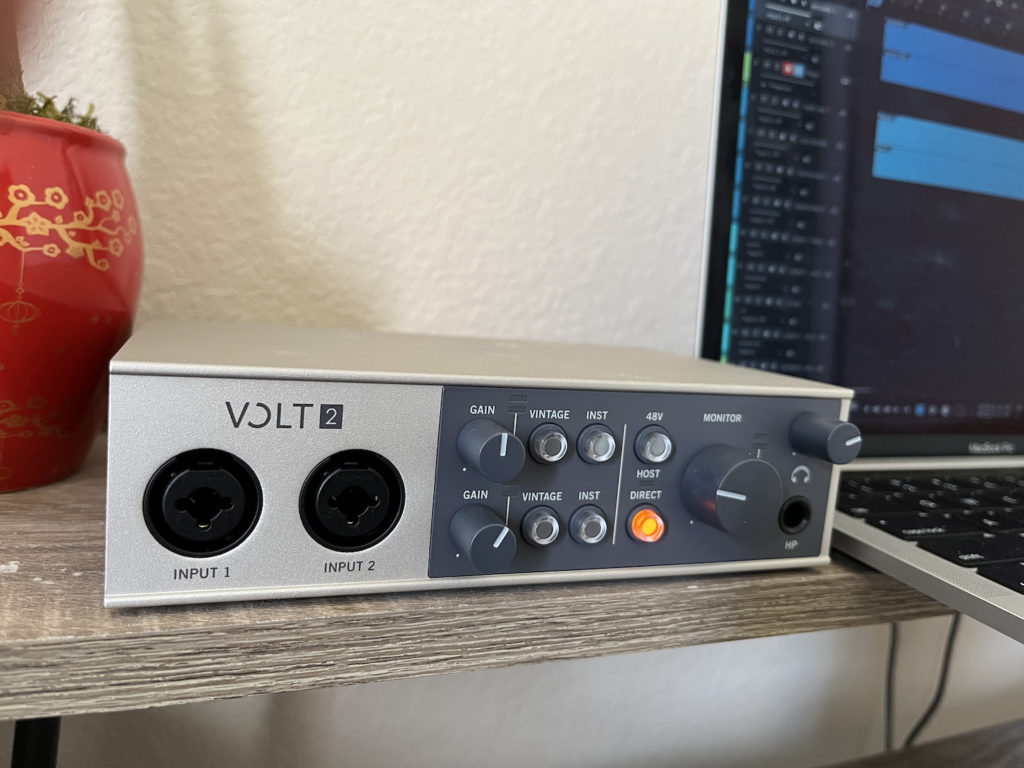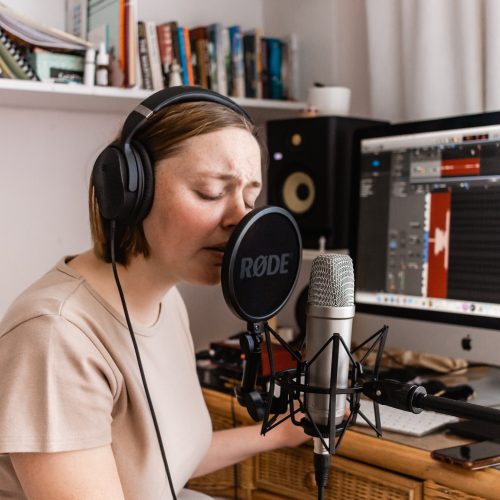Wanna skip to the list right away? Here’s a list of my top picks for USB Audio Interfaces to buy in 2023.
- Focusrite Scarlett 2i2 3rd Gen
- Universal Audio Apollo Solo
- Universal Audio Volt 2
- Antelope Audio Zen Go
- Motu M2
- Audient iD4 MkII
- Native Instruments Komplete Audio 1
- SSL 2+
Whether you’re a hobbyist making music from home, or a seasoned pro with a complete studio setup, your primary tool as a producer must be an audio interface. They help you get the accurate output of your vocals, instruments, and music and even manipulate how it sounds depending on your preferences. In short, they’re a must for recording music in a home studio.
But, what type of audio interface should you get? If you’d ask me, I’d say a USB audio interface is a sweet spot for most producers — especially if it’s a home setup.
It’s portable, convenient, and doesn’t require an external supply for power — just a USB bus. Here’s a roundup of some of my favorite USB audio interfaces you can buy in 2023 as a singer/songwriter, DJ, or producer. I’ve covered their price, description, pros, and cons in detail so that you can make an informed decision about your most essential piece of equipment.
All right – let’s get started!
1. Focusrite Scarlett 2i2 3rd Gen
Price: $160
Pros
- Relatively compact design
- Has an “Air” button to reproduce Focusrite’s ISA mic preamp sound
- Allows easy stereo direct monitoring
Cons
- Not many output options
The top spot on my list goes to the Focusrite Scarlett 2i2 3rd Gen, which has somehow become a staple in most standard home recording setups. It’s compact enough for high portability yet has just enough weight to maintain sufficient stability on a desktop. The buttons, jacks, and control knobs are smartly positioned for comfortable use, and the whole thing feels ergonomic once you get used to it. I especially love its design for the gain level (i.e. the record or input level) indicator.
Ideally, the “just right” spot is where it’s low enough to make sure there’s no distortion in the vocals or instruments and high enough to minimize noise. On the 212, you have LED rings glowing green when the gain level is safe, rad when it’s too high, and yellow when it’s right around the danger zone — and that’s super helpful for beginners and pros alike.
This third generation of USB audio interfaces also features an “Air” for the channels to get even crispier recordings. You also get stereo direct monitoring with this model, which newbies might not care about but happens to be a must-have feature for some professionals. With that said, the Focusrite Scarlett 2i2 3rd Gen has limited compatibility with iOS and doesn’t have a MIDI connection.
If those two caveats aren’t deal-breakers for you (and they probably aren’t — barely anyone needs a MIDI connection these days), grab it here!
2. Universal Audio Apollo Solo
Price: $699 ($469.95 right now on Black Friday sale!)
Pros
- Low latency with a thunderbolt port
- Established brand of audio equipment
- Includes UAD’s Realtime Analog Classics plugin bundle
Cons
- Relatively pricey
Universal Audio (UAD) has delivered some of the most popular audio interfaces in the market with its Apollo series, and it’s been that way for almost a decade. Apollo Solo also belongs to that family! It’s the company’s most recent entry-level offering, which still wears a hefty price tag of just under 700 bucks. But that’s because you get access to pro specifications like high-quality Unison preamps, 2 XLR line/mic combo inputs, a couple of line outputs for studio monitors, a headphone output, an instrument input, etc.
Aside from all those top-notch connectivity features, one of the key selling points is its built-in digital signal processing (DSP). This means it lets you use the native UAD Powered Plugins while mixing and recording, which means way less stress on your computer’s CPU unit.
Whether you’re a complete novice or an experienced producer, you simply cannot go wrong with the Apollo Solo, and that’s partly because it comes with UAD’s Realtime Analog Classics plugin bundle! Find it here.
3. Universal Audio Volt 2

Price: $153 on Amazon
Pros
- Solid build quality
- “Vintage” pre-amp modeling
- Comes with a nice software bundle
Cons
- Pre-amps aren’t as top-notch as on the Apollo
- No LED monitoring display
If the Apollo is a little pricey for your taste, it’s worth looking down Universal Audio’s product line at the Volt 2, a nifty little 2i2 device that was only recently released.
Maybe the most notable thing about the Volt 2 is its “vintage” preamp option. Universal Audio trumpets this as being based on a Universal Audio 610 preamp, with the idea being that it emulates the tube sound used on classic recordings by artists like Ray Charles and Van Halen.
My take: The vintage option is neat, but it’s not game-changing.
That said, I do really like this device for its build quality, software bundle, and low price point. Out of the entry-level audio interfaces I’ve tried, it’s one of the slickest; the dials turn like butter, the profile is pleasing, and the signal (while being a step below the Apollo) is pretty clean. You can read my detailed review of the device here, but the long-and-short of it is that this is a great option to begin building your home studio.
And if you’re interested in giving it a shot, check it out here.
4. Antelope Audio Zen Go
Price: $499 on Amazon
Pros
- Great price for a DSP-capable interface
- Can independently use DSP FX without PC
- Big plugin bundle with guitar FX
Cons
- Its AFX2DAW plugin bridge is only available on Mac
Being a new company, you’ve probably never heard of Antelope, but they’ve already come out with some products in the digital audio niche. The Antelope Audio Zen Go is considerably more affordable than the Universal Audio Apollo Solo listed above, or even the Apogee Symphony Desktop — yet trades blows with these competent models when it comes to specifications.
It has two combination line/instrument/mic inputs, and you can bump that up to four if you’ve already got another interface with a SPDIF out (such as the Scarlett 6i6). The output options aren’t limited either, with two front-panel headphone outputs, as well as TRS and RCA with separate volume controls.
Aside from the significant price gap, the Zen Go has another edge over popular competitors like the Apogee Symphony — and that’s portability. That’s what the “Go” in its name is for, as you don’t even need a power supply for it. It draws power directly through its USB port which adds to the portability.
You get 37 built-in Synergy Core DSP effects pre-packed with this interface, including reverb, EQ, and many other iconic cabinet models and guitar amps. You’ll run these using its onboard DSP, which makes this deal a complete steal — especially for guitar players looking to use FX without a PC. Check it out here!
5. Motu M2
Price: $199.95
Pros
- Features front panel high-resolution level meters
- Each channel has one-touch direct monitoring
- High value for money
Cons
- Lacks creative tone-sharpening hardware tools
Motu is widely regarded as a respectable brand for pro-grade audio equipment, especially when it comes to audio interfaces. Their portfolio isn’t very comprehensive when it comes to entry-level options, but the M2 is a bit of an exception. At under 200 bucks, it’s their most accessible USB interface, and packs in an impressive set of features within a compact form factor. My favorite thing about it is its high-res level meters on the front, which allow you to easily monitor your gain levels while recording (keeping that digital clipping frustration at bay).
It has individual +48v phantom power switches, with each channel having individual one-touch direct monitoring for the ultimate ease of use. At any point during your recording sessions, you’d just be one button press away from monitoring your recording directly, with no latency problems to worry about.
You don’t even need any 3rd party installers to operate the M2 (nor does it come with any) — and that’s a huge plus in my books, especially for someone who doesn’t want to play around with another technical piece of software. You do get loopback via a driver though, and most people won’t need much else.
There’s Ableton Live 10 Lite and MOTU Performer Lite bundled in with the package, which makes it an even better deal for the sub-$200 price bracket. Here it is!
6. Audient iD4 MkII
Price: $199
Pros
- Has an excellent preamp
- Big bang for your buck
- Very easy to use
Cons
- Windows drivers can sometimes be a bit buggy
At number five, I’ve got the Audient iD4 MkII. It’s arguably the most value-for-money USB audio interface on the market for under $200 — which makes it a top choice for a standard home production setup. It has a simple two-output and two-input connectivity layout. It features an instrument level DI for plugging in your bass or guitar, as well as a mic preamp (along with phantom power for condenser microphones). You also get a smart scroll wheel which lets you tweak the software settings based on your preferences. Aside from this, there’s also a main output for your headphones and speakers.
It doesn’t require an independent external power supply as the whole setup gets powered through its USB-C port. Using Apple’s camera connection kit, you can easily hook it up to an iPad or iPhone as well, which makes it a convenient choice for casual hobbyists as well.
Everything about the design and ease of connectivity on this model tells you how thoughtfully Audient has put this thing together. With such a well-rounded user experience, you’ll almost forget that you’re using an entry-level interface. If you’ve got no more than 200 bucks to spend on an upgrade, I’d suggest adding this one to your cart here!
7. Native Instruments Komplete Audio 1
Price: $109 ($89 right now on discount)
Pros
- Most affordable USB interface on this list
- Comes with a useful package of NI plugins
- Simple and easy to set up
- Great for beatmakers
Cons
- Has limited outputs and inputs
Not every musician falls into the same niche, which is why “the right interface” is a subjective term that can’t fit everyone. The Native Instruments Komplete Audio 1, in particular, is great for producers, DJs, and beatmakers who don’t record much but simply create music using software like FL Studio or Ableton Live. This audio interface doesn’t have many frills or advanced features to write about, but it’s light on your pocket and gets the job done.
I love how despite its low-budget price point, it’s still so sturdily built. You put it on your desktop and it feels solid and reliable. Thankfully, it’s just as reliable digitally thanks to its stable drivers. That’s what makes it so appealing to people who don’t want to spend hours trying to figure out how to set it up or troubleshoot random errors and connectivity issues. Even if you’re working with an older computer, the process is almost as simple as plug-and-play.
It comes bundled with a suite of great NI plugins, including Replica, Monark, and the wildly popular Solid Bus Comp compressor. It’ll easily be the best 100-something bucks you’ll spend on a piece of musical equipment. Have a look!
8. SSL 2+
Price: $229.99
Pros
- Its 4K button adds a sound (and it’s not a gimmick)
- Very sturdily built
- An exceptional signal path for its price
Cons
- Not everyone’s a fan of the RCA outputs
Lastly, we’ve got the SSL 2+! With its pro features, easy connectivity, and a compact interface, the SSL 2+ audio interface comes with a promise of the “SSL sound” — but a version of it that even beginners and hobbyists can afford.
With a “+” in its name, you can tell that this model is the advanced version of the standard SSL2, with the main difference being that the 2+ has an additional two outputs on top of the 2-out and 2-in configuration of the SSL2.
It also features a MIDI in/out and a headphone out, both being able to independently monitor separate mixes. Its “4k” button is a special feature that you won’t find on many other audio interfaces, and you can use it to add extra zip to your recordings. Don’t worry, it’s not just a gimmick and does make a difference in the sound — though a lot of its value comes from how “pro” it makes you feel.
To add to its excellent connectivity, there are two combo line/mic inputs as well with high impedance options. You can switch easily between bass, guitar, synth, or drum machine signals through them, so if you’re a fan of producing organic mixes using your own instruments, the SSL 2+ is a solid choice. Its +48v option also lets you connect both dynamic and condenser mics for a smooth recording experience.
If not in your card, the SSL 2+ should at least be in your shortlisted options thanks to its crisp recording quality, a flexible configuration for the I/O. Get it here!
Final thoughts on USB Audio Interfaces
With every generation of USB technology, the devices that rely on it get considerably better because at the end of the day — an easier, more effective connection translates to ease of use. That’s true in the world of audio interfaces as well!
As connections become more compact and faster, the industry continues to set new performance standards.
Years of advancements in technology (and a few hours of my research) have given us these top-quality USB audio interfaces listed above — so all the best in finding the right one for you!







